Wax for decorative plaster: recipes for compositions and application features

The wax serves as a coating for decorative plaster and is the final touch in creating a complete picture. In order for a wall finished with plaster to have a complete look, it is required to apply wax to it. It differs in composition and application characteristics. The waxed surface does not tarnish over time. The protective wax layer prevents the paints from losing their original color, they remain the same juicy after many years.
And not only this is the advantage of wax. It is able to protect the walls from moisture, but at the same time it allows air to pass through, thanks to which the walls breathe, mold and mildew will not appear on them. That is, any of the most luxurious renovations, on which a lot of money has been spent, will delight its owners for many years. But, of course, waxing is directly related to both the application of plaster and the preparation of walls or ceilings. For everything to be beautiful and functional, the technologies of all processes must be observed. There will be no desired effect if in this important chain there was a failure in at least one link.
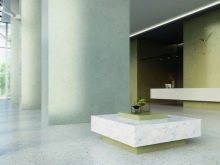

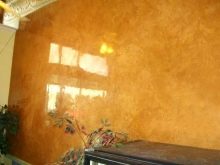
Some are afraid to apply the composition on their own, considering it a difficult process. In fact, this is a completely feasible task, if you do everything according to the instructions and choose the right wax. You can even make it yourself using a proven recipe, as well as achieve the desired shade with the help of additional components.
Variety of coatings
Today, without much difficulty in building supermarkets, you can choose exactly the wax that is suitable for a specific surface, read the instructions for application and get advice from the seller.
When decorating Venetian plaster, wax acts as a protector against moisturewhich creates a thin film. In addition, a wall treated with such wax looks graceful and gains additional shine.
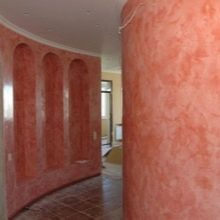
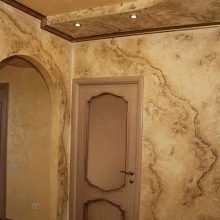
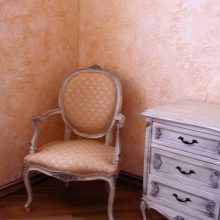
There are two options for choosing a wax in this case. It comes in liquid or gel form. The glossy surface can be simply coated with liquid wax. For porous surfaces, gel wax is suitable.
The wax may contain substances with natural or synthetic ingredients. Beeswax belongs to natural, thanks to which you can create a thin layer on the wall, thereby giving it a shine.
If shine is not of particular importance, you can use a composition made artificially based on synthetic materials. It tends to give the wall a matte finish, but it is believed that this coating is much more reliable and will last longer.
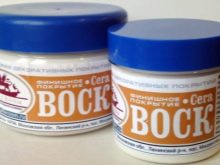
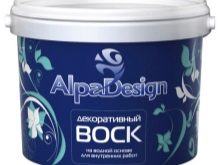

Each wax is water based. Based on this, you can slightly adjust the composition purchased in the store. If it looks too thick, it can be slightly heated, but not over an open fire, but simply place it near a warm place, for example, near a radiator. When it melts, you can add water. Its amount should not exceed three percent. Then it is recommended to leave the composition for three days so that the mass becomes homogeneous. After that, you can start finishing work.
We select for different surfaces
It is impossible to consider the wax coating separately from the type of plaster, since it is the wax that is the logical conclusion of the work that began with the choice of plaster and wall covering.For gypsum plaster, one type of coating is required, for Moroccan or Venetian plaster, another.
It is necessary to dwell on several types of decorative plasters that are especially popular today and options for their coating.
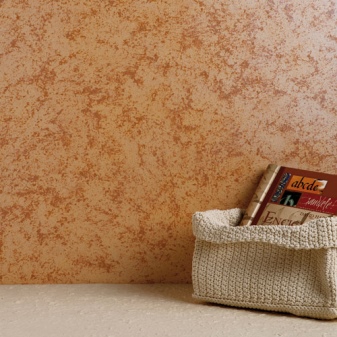
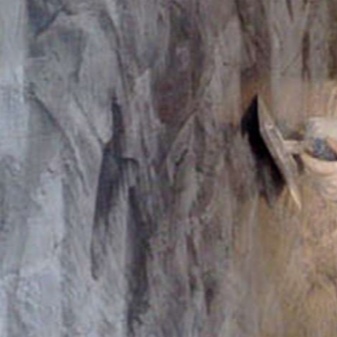
A variety of decorative plasters and wax will allow you to think over the style of the room to the smallest detail and design the coating to match its performance characteristics. For example, provided that the plaster is treated with wax or varnish, you can use it to decorate the bathroom, the bathroom, and the kitchen.
If the choice fell on Venetian plaster, it means that the coating in the room will have a glossy smooth structure, the drawing will be translucent. All this will be possible thanks to the multi-layer technique. As a result, you can achieve imitation of marble, granite, jasper.


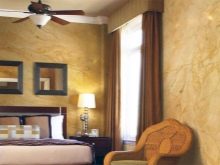
Venetian plaster is applied in several layers. Thanks to such "stone" walls, the effect will be simply amazing. The wax will complement the composition, thanks to it reflections and overflows will appear on the wall. Together, the plaster and wax finish will create not only original design, but also durability. Such a coating will not crack or fade over the years and will last at least 15 years. In addition, after final drying, it can be safely washed without fear of ruining something. After all, it is the wax that creates the protective film for such an expensive coating.
There is another option to achieve the effect of antiquity - with the help of a special varnishafter drying, cracks will appear on the wall. But this is only a visual effect. The strength and quality of the coating will not suffer from this.
There is a Venetian plaster, which already contains wax, and such a coating, due to its waterproofness, can even be used in bathrooms.
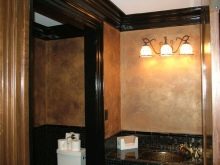
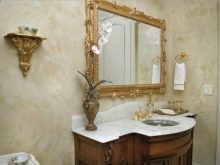
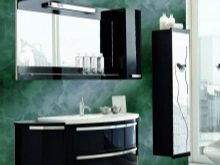
Venetian plaster is most often preferred to be treated with transparent wax, since the color of the plaster itself is usually thought out so that it does not need an additional shade. The only exceptions are those cases when, in addition to brilliance, it is also necessary to achieve an ebb and flow of gold or silver. This effect can be easily achieved by adding special components.
For other types of plaster, you can use colored wax, which allows you to create a variety of shades on the wall. This option is suitable for Moroccan plaster.
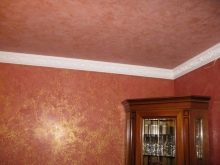

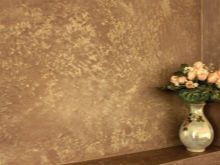
It contains wax and linseed oil, which also creates a water-repellent effect. The preparatory and relief layer creates unique patterns on the wall. The upper protective layer, the application of which is necessary at the final stage, is applied with wax. And his presence is required. Therefore, experts recommend purchasing a finished product so that the coating turns out exactly as it should be. Then, for a long time of operation, there will be a guarantee that the plaster will not undergo destruction and deformation. As a final step, you can add gold leaf to the wax to create a veining effect. Moroccan plaster is just the case when you can, if desired, treat areas with colored wax to enhance the effect, give the colors depth and saturation.
How to apply?
In order for the wall to have a uniform shade without transitions, work cannot be interrupted. Then the wall will have a uniform structure and color. If it can be difficult for one not quite experienced master, then it is much easier to cope with this task together.
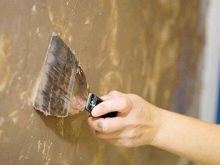
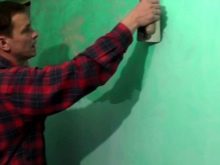
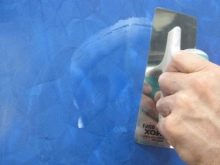
When buying wax, it is recommended to calculate in advance the area to be covered. Consumption can be different, and it depends on the composition of the wax and plaster, which was used to treat the wall, as well as on the final effect to be achieved.
After all layers of plaster have been applied to the wall and they have dried well, you need to prepare the surface for the waxing procedure. It is necessary to carefully examine the entire area again for any previously unnoticed flaws.After applying wax, fixing them will be very problematic. The wall should be free of dust. If it was previously wiped with a damp cloth, you need to give it some time to dry.
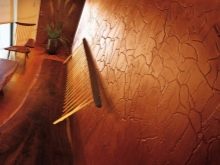


When waxing, the surface must be absolutely dry and clean.
The most important thing is accuracy and no rush.
Professionals usually apply wax with a trowel, or use a rubber trowel. For beginners, it will be easier if you take a small amount of wax and treat small surfaces. This is more likely to avoid defects, since the wax dries quickly and if you do not act quickly enough, the surface can be uneven. The wax is rubbed over the surface with a clean white soft cloth, preferably flannel, until the wall starts to shine.
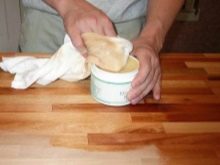
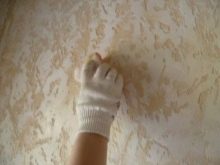

The drying time of the wax depends on which company it is produced. Some manufacturers promise that the wax will dry within three hours, while others have the number six on the packaging. But in any case, complete hardening will occur in a period of two to three weeks. After that, it will not be dangerous to treat the walls with a damp cloth and use non-aggressive detergents.
Wax has endless possibilities - it is this final chord that will add zest to your room. The main thing is to master the technique of its application well. If necessary, you can create relief on the surface or experiment with different colors. But you shouldn't do it just like that. There must be a clear idea of how it will look in reality. And a pre-thought out sketch will not hurt at all. This will avoid unnecessary frustration. It's even better if you start with a small wall and not a central one, but an inconspicuous one. This will allow you to get the first experience and take into account errors while continuing the repair on more visible surfaces.
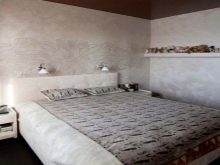
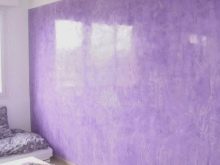

Error correction
If, after the completion of the work, some flaws are found on the wall, then it is not too late to fix them right away. But after four hours, it will be difficult to do this. So it's better to hurry up. Excess is well removed with a clean cloth. If it doesn't work, you can slightly moisten it in white spirit and wipe the surface.
It also happens that the composition has completely hardened, and only then some flaw rushed into the eye. Don't panic. In some cases, a construction hairdryer can come to the rescue. It heats up the area where the defect is found. Then the coating is washed off with hot water. You can try to treat the damaged piece with a special solvent, which is used to remove the primer from the wooden surface.
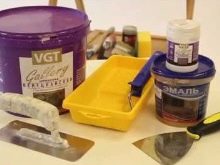
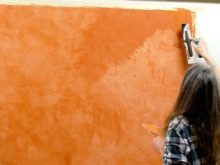

It should be borne in mind that after all the manipulations, this area may look different than the entire wall.
Therefore, it is better to eliminate all errors at once, as they say, “in hot pursuit”. Better yet, avoid them altogether.
This is not so difficult to do. When working with wax, do not put too much on a trowel or putty knife. It is better to take a little, grind it well, work gradually in small areas, moving gradually in one direction. Then the coating will lie in a uniform layer.
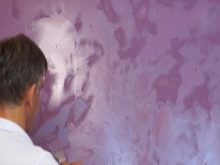
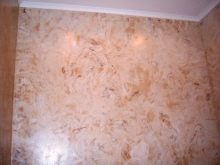

According to masters who have experience in applying plaster and wax, there are types of coatings on which after a few days nothing can be fixed and you do not even need to try so as not to make it even worse. This is a wax that contains an acrylic component. It cannot be melted with hot air and washed off with any chemicals. The film is very durable. This is a very good and high-quality wax, but, most likely, it is better to use it if you have confidence in your abilities and at least a little experience with plaster.
Wax is the final stage, thanks to which it is possible to achieve a gloss and an interesting effect on the surface. But sometimes it happens that the color of the applied plaster in reality differs from the one that was originally conceived.This often happens to those who are working with this kind of material for the first time. It is difficult and troublesome to remodel the wall, and it is also expensive, given that decorative plaster is not distinguished by its low cost. There is a chance to fix everything with wax. You can buy yellow, which will give the effect of light gilding. If you add silver to the colorless wax, you can achieve a silvery shade on the surface.
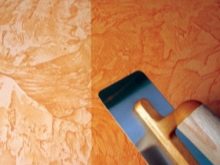

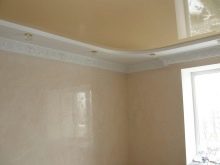
In most cases, it is used for covering walls with transparent wax or a yellow tint. There are also colors that allow you to make the shade yourself.
For decorating textured plaster, compositions containing pearlescent, gold or silver components are often chosen. Colored wax is more suitable if you need to create a Moroccan interior or imitation of natural stone.
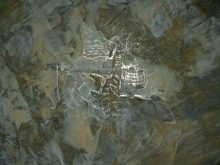

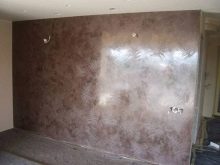
How to do it yourself?
You can use homemade wax as well, but it's a good idea to test on a surface to see what it looks like before applying it to the wall for final decoration.
The base will be glue for non-woven wallpaper. It must be diluted according to the instructions, mixed very well with a construction mixer or a special drill attachment. If neither one nor the other is available, a regular mixer will do. You should get a homogeneous mass without a single lump. Then the panel glossy varnish is added, all this is thoroughly mixed. If it is planned that the wax should have a shade, paint with a gold or silver effect is added at the end.
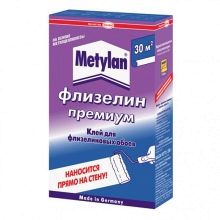

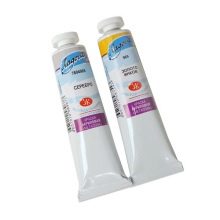
You can go the other way. The base of the wax will be a transparent wax bought in a store, and silver, bronze or golden fine powder will suit it as additional components. Such a composition will give the wall a gloss and shimmer - bronze, silver or gold, depending on the selected component.
Cost and quality
The price of wax depends on the manufacturer and the materials (natural or synthetic) from which it is made. To roughly navigate how much wax you may need, you can take as a basis the average, which is from 50 to 70 grams per square meter. The price for a coating for decorative plaster varies from four hundred to four thousand rubles.

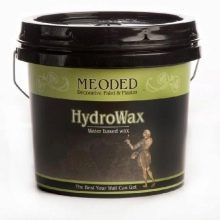
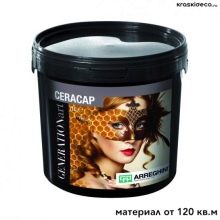
For example, a kilogram of VGT wax made in Russia can be bought for 440 rubles, the same volume for Venetian plaster is only ten rubles more. This type of coating is made using synthetic materials. With natural ingredients, the mixture is much more expensive. Coating "Cera di Veneziano" (Russia) will cost 3900 rubles per liter. This is exactly the amount in the package. Colored wax from Sweden from Parade will cost from 700 to 800 rubles.
The choice, of course, is up to the consumer. But the masters strongly recommend not to save on the purchase of wax, if only for the reason that if initially you cannot see the differences, it is not known how the wax will behave after several years of operation and how the surface will look like.
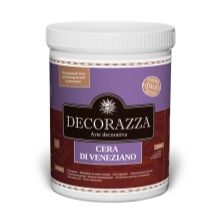
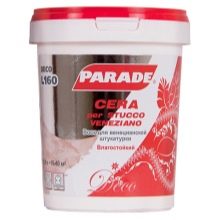
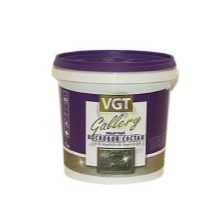
This primarily applies to Venetian plaster, where wax is considered one of the most important components. Whether the top layer will protect the wall and delight with shine and gloss depends on the finishing work that is done with wax. And one more plus in favor of natural wax - only about this product we can say with confidence that it is one hundred percent non-toxic. In addition, high-quality wax is more pleasant to work with, it lays down and spreads better over the surface. This means that working with him is a pleasure.
The Italian company Cebos-Ecocera is considered one of the leaders in terms of the number of sales and the quality of the products offered in this area. The content of white beeswax in this coating guarantees long-term reliable surface protection and a bright gloss, which will certainly delight with its colors and overflows.
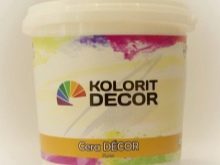
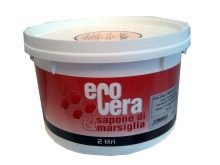
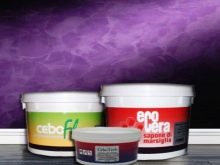
What to replace?
You cannot do without finishing the plaster with wax, because it will not get the finished look that it was planned to give it. But in some cases, when, for example, there is not enough skill when applying wax or it was not possible to buy the desired option, there is an alternative. Varnish has the same function as wax. It protects the surface from harmful influences, retains the paint for a long time, and adds shine.
A few days after treatment with varnish, the surface can be safely washed with a damp cloth without fear of damaging the coating.
Varnishes also have their own classification. For decorative plaster, those are intended that have safe compositions for humans and dissolve with water. The varnish can be more matte or glossy, it can vary in drying time.
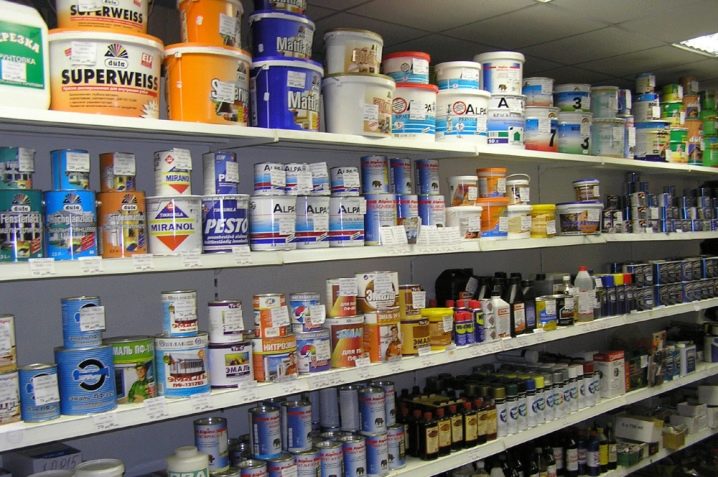
The main thing that you need to pay attention to when choosing one or another composition is that it is breathable and at the same time moisture resistant. These characteristics are the most important.
Usually, for the treatment of decorative plaster, an acrylic varnish is chosen, which is water-based. It is odorless, non-toxic and considered an environmentally friendly material.
When dry, the white liquid turns into a protective transparent layer, which gives the wall a glossy shine and does not change colors at all. Sometimes this solution is tinted if there is a need not only to give the surface a gloss, but also to add a shade.
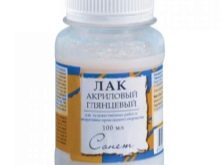
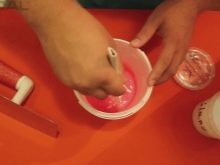
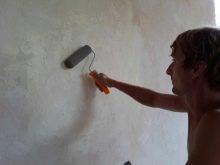
The varnish usually dries very quickly. Three hours are enough for complete drying. In addition, varnish is used when it is necessary to give the surface an antiquated effect and make cracks. In such cases, a mother-of-pearl varnish is usually used. It gives a silvery or golden tint.
Applying varnish to the wall is not a difficult process, but even pleasant. But you need to take into account some points that will facilitate the work and improve the quality of the final coat. Before applying varnish to the plastered surface, it must be treated with a primer. It will protect the surface from mold and mildew in the future, strengthen the plaster and reduce the consumption of varnish. It is applied in several ways: by spraying or using a brush, roller, sponge.
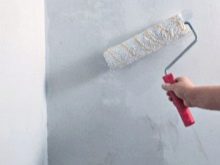
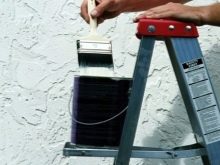
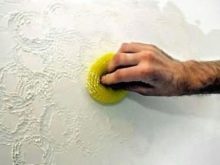
As for varnish, it is easier to correct mistakes with it than with wax. It is enough to remove the old layer with a special solution and apply a new one.
Reviews
Before doing this or that work, you can take advantage of the reviews of professional craftsmen or those who decided to make repairs, using for the first time such types of coatings as decorative plaster and wax.
As many have noted, the advantages of plaster wax are obvious. The coatings processed by him look chic and elegant. Any room can be changed beyond recognition. Thanks to correctly selected colors and textures, the design of the room looks harmonious.
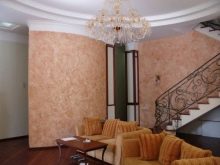
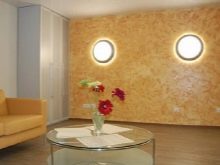
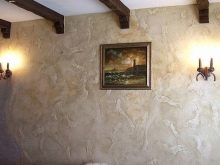
Housewives emphasize that surfaces treated with wax in compliance with all technological processes do not deteriorate over time, even under the influence of moisture. And the fact that they are easy to care for is very important.
A number of consumers point out that both plaster and wax are expensive materials that must last for a long time. Therefore, you need to treat them very carefully.
It must be borne in mind that if a separate fragment is damaged, it will be impossible to restore the original version. During restoration, the shade will necessarily differ from the general one. Sometimes the shades are chosen so carefully that then it is simply unrealistic to achieve exactly the same tone. Even the best master cannot do this. There can be only one option in this case - to change the entire coverage.

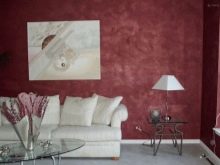

One conclusion can be made: when choosing decorative plaster, you should immediately think about what wax will be used as a topcoat and purchase all the necessary materials and tools.
For information on how to apply wax to decorative plaster, see the next video.













The comment was sent successfully.